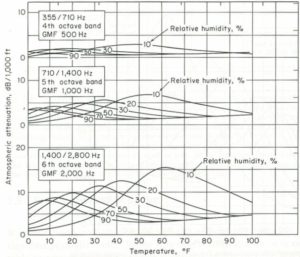That Crackly Sound
12.18.2009 | HMMH |by Doug Barrett
Four more days to go until the longest night of the year and it’s starting to get cold here in New England! Last night’s low was around 14 degrees F. in Boston, and last weekend, up in New Hampshire, it was colder still. My fabulous spouse and I live about five miles from Boston’s Logan International Airport, and depending on which way the wind is blowing, sometimes we are treated to a steady stream of departing aircraft. The other day, after a particularly cold morning, she asked why the aircraft sound different in cold weather – both louder and “crackly” as she put it.
The short answer is that it’s complicated. As for the long answer, I suspect that she’s noticing the dependence of atmospheric absorption of sound on temperature and relative humidity. Leo Beranek said it better than I could: “energy is extracted from a sound wave by rotational and vibration relaxation of the oxygen molecules in the air. The vapor content of the air determines the time constant of the vibration relaxation… In addition, this ‘molecular absorption’ depends in a major way on temperature.” (Leo L. Beranek, Noise and Vibration Control, McGraw Hill, 1971, P.170)
It’s especially interesting that at any particular relative humidity, molecular absorption peaks at a given temperature. In other words, one can’t simply make a generalization that sound “travels” better when it’s cold outside. Adding to the complexity, the effects of temperature and humidity vary dramatically depending upon the frequency of the sound. In general, wider variations exist at higher frequencies. Notice on the first figure below (reproduced from Beranek) that there is relatively little sensitivity to temperature or humidity at 500 Hz – only about 3 dB per 1,000 feet across a temperature range of 100 degrees F. In contrast, at 8 kHZ, the second figure shows a whopping variation of up to 50 dB per 1,000 feet over the same temperature range.
Regarding the “crackly” sound, here are some molecular absorption values that I pulled from the figures: At 500 Hz to 1 kHZ (approximately speech frequencies), one expects molecular absorption at a rate of about 1 to 2 dB per 1,000 feet of propagation on either a pleasant summer morning (60 degrees F. and 50% RH) or on a nippy winter morning (10 degrees F. and 20% RH). That is to say, at lower to mid-range frequencies, there’s not a big seasonal difference. At 8 kHZ, however, one expects absorption at a rate of about 20 dB per 1,000 feet with the summer conditions, but only about 6 dB per 1,000 feet with the winter conditions. Less high-frequency absorption with cold, dry weather equals more “crackly” sounding!







